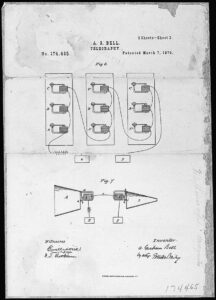The word telephone, from the Greek roots tēle, “far,” and phonē, “sound,” was applied as early as the late 17th century to the string telephone familiar to children, and it was later used to refer to the megaphone and the speaking tube, but in modern usage it refers solely to electrical devices derived from the inventions of Alexander Graham Bell and others. Within 20 years of the 1876 Bell patent, the telephone instrument, as modified by Thomas Watson, Emil Berliner, Thomas Edison, and others, acquired a functional design that has not changed fundamentally in more than a century. Since the invention of the transistor in 1947, metal wiring and other heavy hardware have been replaced by lightweight and compact microcircuitry. Advances in electronics have improved the performance of the basic design, and they also have allowed the introduction of a number of “smart” features such as automatic redialing, call-number identification, wireless transmission, and visual data display. Such advances supplement, but do not replace, the basic telephone design. (Read more)

To read about telephone components, see next page.


